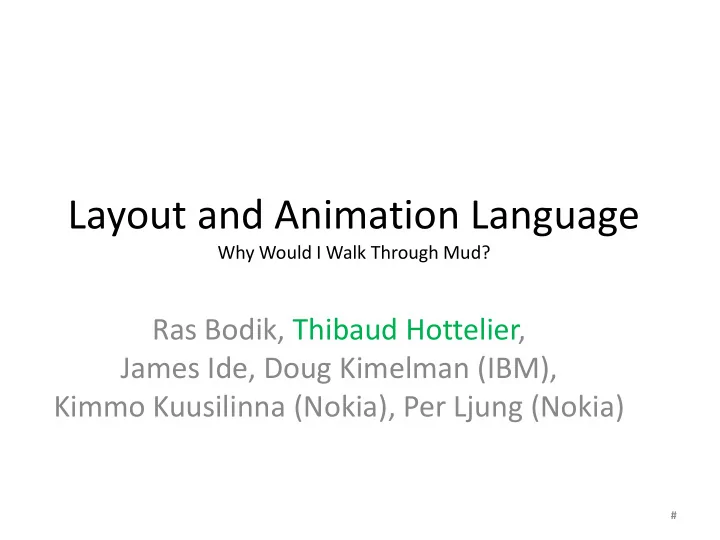

Layout and Animation Language Why Would I Walk Through Mud? Ras Bodik, Thibaud Hottelier, James Ide, Doug Kimelman (IBM), Kimmo Kuusilinna (Nokia), Per Ljung (Nokia) #
NY Times 2
How Fancy Layout Are Created Today Pick a canned layout from ProtoViz (DSL for vis.) – Limited to the library. – Non-programmers cannot define their own. If programmer, must write own layout engine. – May takes days => can’t quickly try layout ideas. – ~10x more code if using Python/JavaScript 5
Our Language Mud We choose declarative programming because • Empower designers – Designers know the “what”, but not the “how” • Naturally maps on human thought process for layout/visualization if well designed • Eventually, programming by demonstration Our compiler does synthesis . Why not use an off-the-shelf constraint solver? Ex: Cassowary[Badros], SMT solvers, Prolog. • Performance – We compile down to tree passes. Linear Time. – No search and backtrack. 6
TreeMap of Financial Industry NY Times 7
TreeMap on the Drawing Board Designer’s View • Area is market capitalization • Companies stacked vertically (or horizontally) • Parent exactly encompasses children 8
Mud Hello World <A> 1. Document is a tree. <B/> 2. We place local constraints <C/> </A> C.w = B.w = A.w / 2 A In TreeMap, we have two building blocks B C • H, the horizontal divider A • V, the vertical divider B C 9
Specification of V Let’s write the spec in English and then translate it progressively into Mud English Specification: 1. V is a rectangle with some style. 2. V area is divided vertically among its children 3. V’s children are stacked on top of each other. 4. V area is proportional the sum its children’s capitalization V Cap = 30 Cap =70 10
The Three Constraints trait VDiv(h, w) { // vertical division h = children[0].h + children[1].h w = children[0].w = children[1].w } trait VStack() { // vertical stacking children.left = 0 children[0].top = 0 children[0].h = children[1].top } trait TreeMap(h, w, cap) { // area =~ cap SCALE * cap = h * w cap = children[0].cap + children[1].cap } 11
V Is a Composition of Trait Let’s declare two new building blocks: let V with RelCoord, BasicBoxStyle, VDiv, VStack, TreeMap let H with RelCoord, BasicBoxStyle, HDiv, HStack, TreeMap “Trait”: Composable unit of behaviour 12
Are we done? Tool: “your treemap is under- constrained” – There are distinct ways to lay it out: Fix: Root.h = 640 Alternative fix: set the aspect ratio. Benefits of our semantics: – Show possible solutions ==> Designer-friendly debugging – Unique solution ==> predictable layout. 13
Prototyping with Mud Mud flexibility allows designers to experiment. Example: Let’s make treemap fixed size! – At Root node: h = 640, w = 320 – Tool tells us to make the scaling factor a variable Mud compiler produces the new layout engine – New engine requires four, rather than three passes – The extra pass computes the right scaling factor. 14
Animations How to add animation? ie, transform the tilemap from Jan to Feb layout? 1. Interpolate Jan-to-Feb capitalization data, obtaining new capitalization for each frame 2. Update the document tree with this data 3. Rerun the layout engine (recompute layout) 15
Radial Layout Polar coordinates in Mud trait Polar (x, y, ω , radius) { x = parent.x + radius * cos( ω ) y = parent.y + radius * sin( ω ) } 16
Under the Hood Specifications TreeMap Table SideBar Bi-directional constraints Declarative/relational Building Blocks Directional constraints Prop Fun Dependencies Prop Fun Operational/functional Functions Attribute Grammar AG compiler [Leo & Adam] Layout Engine Tree traversals 18
Ongoing Work The rubber meets the mud: – Data visualization: this summer @ Nokia Lab – GUIs, documents will be next – Learn how designers would use and debug Mud Come see the demos at poster session – Vertical integration of almost entire browser stack – Give us your ideas for data vis of personal data 19
Summary • Declarative programming for designers (data visualization, GUIs, documents). • Fast layout for big data and small battery. No search, no fixed-point. Instead, linear time, parallel. • Constraints compiler based on two-step synthesis. Local constraints to functions. Functions to global solver. 20
That is all folks 21
Recommend
More recommend